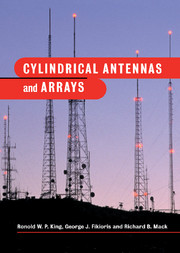Book contents
- Frontmatter
- Contents
- Preface
- Preface to first edition
- 1 Introduction
- 2 An approximate analysis of the cylindrical antenna
- 3 The two-element array
- 4 The circular array
- 5 The circuit and radiating properties of curtain arrays
- 6 Arrays with unequal elements: parasitic and log-periodic antennas
- 7 Planar and three-dimensional arrays
- 8 Vertical dipoles on and over the earth or sea
- 9 Dipoles parallel to the plane boundaries of layered regions; horizontal dipole over, on, and in the earth or sea
- 10 Application of the two-term theory to general arrays of parallel non-staggered elements
- 11 Resonances in large circular arrays of perfectly conducting dipoles
- 12 Resonances in large circular arrays of highly conducting dipoles
- 13 Direct numerical methods: a detailed discussion
- 14 Techniques and theory of measurements
- Appendix I Tables of Ψd R, T(m) or T′(m) and self-and mutual admittances for single elements and circular arrays
- Appendix II Tables of matrix elements Φu and Φυ for curtain arrays
- Appendix III Tables of admittance and impedance for curtain arrays
- References
- List of symbols
- Index
1 - Introduction
Published online by Cambridge University Press: 07 August 2009
- Frontmatter
- Contents
- Preface
- Preface to first edition
- 1 Introduction
- 2 An approximate analysis of the cylindrical antenna
- 3 The two-element array
- 4 The circular array
- 5 The circuit and radiating properties of curtain arrays
- 6 Arrays with unequal elements: parasitic and log-periodic antennas
- 7 Planar and three-dimensional arrays
- 8 Vertical dipoles on and over the earth or sea
- 9 Dipoles parallel to the plane boundaries of layered regions; horizontal dipole over, on, and in the earth or sea
- 10 Application of the two-term theory to general arrays of parallel non-staggered elements
- 11 Resonances in large circular arrays of perfectly conducting dipoles
- 12 Resonances in large circular arrays of highly conducting dipoles
- 13 Direct numerical methods: a detailed discussion
- 14 Techniques and theory of measurements
- Appendix I Tables of Ψd R, T(m) or T′(m) and self-and mutual admittances for single elements and circular arrays
- Appendix II Tables of matrix elements Φu and Φυ for curtain arrays
- Appendix III Tables of admittance and impedance for curtain arrays
- References
- List of symbols
- Index
Summary
Linear antennas
Wireless communication depends upon the interaction of oscillating electric currents in specially designed, often widely separated configurations of conductors known as antennas. Those considered in this book consist of thin metal wires, rods or tubes arranged in arrays. Electric charges in the conductors of a transmitting array are maintained in systematic accelerated motion by suitable generators that are connected to one or more of the elements by transmission lines. These oscillating charges exert forces on other charges located in the distant conductors of a receiving array of elements of which at least one is connected by a transmission line to a receiver. Fundamental quantities which describe such interactions are the electromagnetic field, the driving-point admittance, and the driving-point impedance. These can be easily determined if the distributions of current on the array elements are known. The determination of the currents on the array elements is the main concern of this book. In this first chapter, the basic electromagnetic equations are formulated and applied to a single antenna in free space. The simplest approach of assuming the current rather than actually determining it is reviewed first. Then, integral equations for the current distributions are derived, and determining the current by numerical methods is discussed. These discussions serve as an introduction to the analytical theory of antennas and arrays based on the solution of integral equations that is presented in subsequent chapters.
Figures 1.1a and 1.1b show two simple practical radiating systems. In Fig. 1.1a, a section at the open end of a two-wire transmission line has been bent outward to form a dipole antenna.
Information
- Type
- Chapter
- Information
- Cylindrical Antennas and Arrays , pp. 1 - 30Publisher: Cambridge University PressPrint publication year: 2002
Accessibility standard: Unknown
Why this information is here
This section outlines the accessibility features of this content - including support for screen readers, full keyboard navigation and high-contrast display options. This may not be relevant for you.Accessibility Information
- 1
- Cited by
